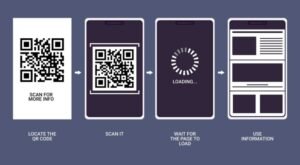Best Practices for QR Code Marketing

Quick Response (QR) codes have made a comeback in recent years, becoming one of the most versatile tools in a marketer’s toolkit. Whether you’re looking to connect with customers at an event, promote a new product, or bridge the physical and digital world seamlessly, QR codes can help you achieve your goals efficiently. But having a QR code isn’t enough. To unlock its potential, you need a strategy that ensures it’s used effectively and enhances your customer’s experience.
This blog will explore the best practices for QR code marketing, providing you with clear and actionable steps to take your campaigns to the next level.
What Are QR Codes, and Why Are They Effective?
QR codes are two-dimensional barcodes that, when scanned using a smartphone or tablet, can direct the user to various digital destinations like websites, apps, or multimedia content. Their ability to instantly connect users to online platforms makes them an invaluable marketing tool.
Why are QR codes so popular?
- Convenience: They eliminate the need to manually enter URLs or details.
- Cost-effectiveness: Once created and implemented, QR codes are free to use and reuse.
- Measurability: Advanced QR code platforms enable businesses to track user engagement, offering crucial insights for improving campaigns.
- Wide adoption: Modern smartphones and devices easily scan QR codes without requiring third-party apps.
But like any marketing strategy, careless use of QR codes can lead to inefficiency, frustration, or reduced engagement. By following key best practices, you can ensure these scannable codes enhance your marketing efforts.
How to Use QR Codes in Your Marketing Strategy
1. Start With a Clear Purpose
Every QR code you use should have a specific and measurable purpose. Ask yourself, “What action do I want the user to take after scanning this code?” The purpose must be clear and relevant to your audience. For example:
- Direct customers to your online store or landing page for exclusive offers.
- Encourage app downloads with a direct store link.
- Share video tutorials or behind-the-scenes content to engage users.
- Collect customer feedback or reviews via a digital form.
By defining the goal upfront, you can ensure your QR code aligns with the broader strategy and provides value to your customers.
2. Ensure Your QR Codes Lead to Mobile-Friendly Content
One of the most common mistakes marketers make is linking QR codes to platforms or content that isn’t optimized for mobile devices. Since QR codes are scanned on phones or tablets, users must have a seamless mobile experience. For example:
- Avoid desktop-based designs or files that require extensive zooming or scrolling on mobile screens.
- Test every landing page or link for speed and responsive design.
When users scan a QR code, they’re expecting simplicity. If the linked content frustrates them, it could harm not only campaign performance but also brand reputation.
3. Design QR Codes for Visibility and Appeal
While QR codes used to have a basic black-and-white square design, modern codes can be highly customized. A well-designed QR code enhances the visual appeal of your marketing materials and drives higher engagement. Here’s how you can do it:
- Use striking colors that stand out while maintaining enough contrast to ensure scannability.
- Embed logos or brand elements within the QR code to reinforce branding.
- Pick an appropriate size. A QR code should be at least 1 x 1 inch (2.54 x 2.54 cm) to remain scannable, though larger is better for posters or signs.
However, as you customize your QR codes, be sure not to compromise functionality. Always test them to confirm that they scan successfully across various devices.
4. Place QR Codes Strategically for Maximum Engagement
Placement matters as much as the code itself. Think about how your audience will encounter and interact with the QR code. Best practices for placement include:
- High-traffic areas: Use posters, digital displays, or signage in locations with plenty of foot traffic.
- Product packaging: Include QR codes on labels or boxes for recipes, product details, or warranty registration.
- Printed materials: Add QR codes to business cards, brochures, flyers, or event badges, ensuring they’re visible without cluttering the design.
- Email or social media campaigns: Use QR codes to transition customers from online platforms to exclusive digital content.
Accessibility is key; users should never have to bend, stretch, or search awkwardly to scan a QR code.
5. Add a Clear Call-to-Action
While QR codes are functional, they’re ineffective without clear instructions. Users need to know why they should scan the code and what they’ll gain from it. Combine QR codes with a compelling CTA to motivate users. For example:
- “Scan now to unlock 20% off!”
- “Watch our full demo here.”
- “Sign up in seconds by scanning this code!”
CTAs add context and create urgency, improving the likelihood of clicks.
6. Monitor and Analyze Performance
QR codes provide measurable insights, so don’t miss the opportunity to track their performance. Advanced platforms like QR Code Generator, Beaconstac, or Flowcode allow you to:
- Monitor scan metrics, such as time, location, and device type.
- Analyze customer interactions with the content linked to the QR code.
- Identify which campaigns and platforms deliver the highest engagement.
Use these analytics to tweak strategies, improve future campaigns, and better understand customer behavior.
7. Protect and Build Trust
With the rise of QR codes, scams have also emerged. Customers are increasingly wary of scanning unfamiliar codes, which means marketers need to make an effort to build trust. Here’s how:
- Add branding around the code (such as a logo or text) to show legitimacy.
- Link trustworthy, encrypted websites to your QR codes (HTTPS).
- Use dynamic QR codes you can update for the same campaign, ensuring links don’t expire over time.
The more secure and transparent your QR codes appear, the more likely users are to scan them without hesitation.
8. Experiment With Dynamic QR Codes
Dynamic QR codes bring flexibility to your campaigns. Unlike static codes, dynamic codes can have their destination links changed even after they’ve been printed or distributed. This flexibility allows you to:
- Correct errors without reprinting materials.
- Update to new campaigns or content for seasonal offers.
- Split test different destinations to identify what drives higher engagement.
Dynamic codes also enable advanced analytics, helping you measure ROI more effectively.
QR Code Marketing Done Right
QR codes have the unmatched ability to bridge offline and online experiences when used strategically. By following these best practices, you can ensure your QR code campaign is not only effective but also delightful for your audience to engage with.
Take Action Today
Transform how you connect with your audience by creating smarter, more engaging QR code campaigns. Whether you’re introducing a new product, gathering customer feedback, or boosting traffic to your website, QR codes unlock endless possibilities.
Start your QR code marketing campaign today and enhance your results with these simple yet effective strategies! Remember to constantly track your progress and make adjustments as needed. With the right approach, QR codes can elevate your marketing efforts and drive success for your business.







